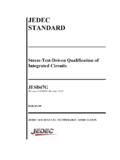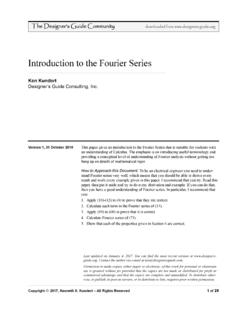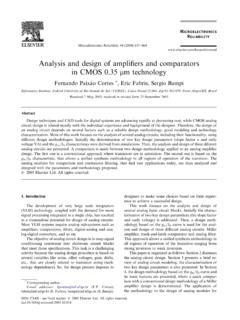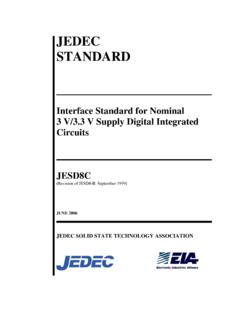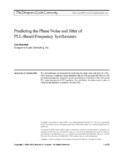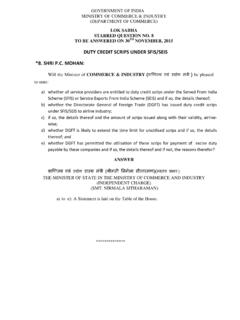Transcription of Introduction to Phasors - The Designer's Guide …
1 The Designer s Guide Communitydownloaded from 2011, Kenneth S. Kundert All Rights Reserved1 of 25 Version 1b, 21 September 2011 This paper gives an Introduction to Phasors and AC small-signal analysis with an emphasis on demonstrating how one can quickly understand the behavior of simple AC circuits without detailed calculations by examining the circuit and using high level updated on September 23, 2011. You can find the most recent version at Contact the author via e-mail at to make copies, either paper or electronic, of this work for personal or classroomuse is granted without fee provided that the copies are not made or distributed for profit orcommercial advantage and that the copies are complete and unmodified.
2 To distribute other-wise, to publish, to post on servers, or to distribute to lists, requires prior written to PhasorsKen KundertDesigner s Guide Consulting, to Phasors2 of 25 The Designer s Guide Introduction22. Phasors33. phasor Model of a Resistor44. phasor Model of a Capacitor45. phasor Model of an Inductor56. Impedance and Admittance57. DC78. Visualizing Impedance and Admittance79. Voltage and Current Dividers1410. Simple Filters1711. Simple Active Filters1912. If You Have Questions21 Appendix A. Immittance Charts211 IntroductionPhasor analysis allows you to determine the steady-state response to a linear circuitdriven by sinusoidal sources with frequency f.
3 This is something that is very example, one can use phasor analysis to characterize the frequency response of acircuit by performing phasor analysis over a range of frequencies. To understand whatphasor analysis is, lets parse this statement carefully. The statement consists of threeparts:1. phasor analysis determines the steady-state response ..2.. to a linear circuit ..3.. driven by sinusoidal sources with frequency first part of this statement assumes that we wait for the steady-state response, mean-ing that we are assuming that the circuit is stable so any transient behavior dies awayover time the response becomes completely repetitive.
4 With this statement we areassuming that we have waited for that initial transient behavior to disappear. In otherwords, phasor analysis computes only the steady-state behavior. The second partassumes that the circuit is linear. This means that the circuit is constructed from linearcomponents , such as simple resistors, capacitors and inductors. Nonlinear componentssuch as transistors are specifically excluded . The third part is the assumption that all . A linear component is one whose response is proportional to its input.
5 For example, a resistoris linear if V=IR because voltage V, the response, is proportional to I, the input with the con-stant of proportionality being R. Notice that if you double I the resistor will respond by dou-bling V. An example of a nonlinear component is a diode, where I=IseV/Vt 1). In this case theoutput (the current I) is not proportional to the input (the voltage V). Specifically, doubling Vmore than doubles I.. If your circuit includes transistors or other nonlinear components, all is not lost. There is anextension of phasor analysis to nonlinear circuits called small-signal analysis in which you lin-earize the components before performing phasor analysis.
6 This is the basis of the AC analysesof SPICE. Furthermore, the transistors may be combined into a circuit that in composite can betreated as linear, such as if the transistors take the form of an to Phasors3 of 25 The Designer s Guide sources in the circuit are purely sinusoidal with the same frequency f. It turns outthat this assumption is not much of a restriction given the other assumptions we havealready made. With the circuit being linear, if two frequencies are present simulta-neously they can be handled separately because of superposition (if there are two fre-quencies present, f1 and f2, then when computing the response at f1 you can completelyignore the signals at f2 and visa versa).
7 Furthermore, with the assumption of steadystate, if a source is not producing a sinusoidal value, we can always use Fourier analysisto decompose it into a collection of sinusoids at different frequencies [3]. Then usingsuperposition, we can analyze the circuit at each frequency is possible to use phasor analysis to analyze arbitrarily complex linear circuits. How-ever in this Introduction a simplified analysis is presented that starts by presenting thebasic phasor models for resistors, capacitors, and inductors, and then build up to modelsof simple series and parallel combinations of these components.
8 Then, a graphical inter-pretation can give you a pretty good understanding of a simple RLC circuit sinusoid is characterized by 3 numbers, its amplitude, its phase, and its frequency. Forexample,(1)Here A is the amplitude, is the phase, and f is the frequency, where . In a cir-cuit there will be many signals but in the case of phasor analysis they will all have thesame frequency. For this reason, the signals are characterized using only their amplitudeand phase. The combination of an amplitude and phase to describe a signal is the phasorfor that signal.
9 Thus, the phasor for the signal in (1) is .In general Phasors are functions of the frequency , and so it would be more appropriateto refer to the amplitude and phase of the phasor using A( ) and ( ), but this formal-ism will be neglected so that the equations presented appear less cluttered. But youshould always keep in mind that in general, Phasors are functions of it is preferable to represent a phasor using complex numbers rather than usingamplitude and phase. In this case we represent the signal as:(2)where V is a complex number, returns the real part of its argument and.
10 Inthis case V is the phasor . It can either be given in rectangular or polar form, so either V =VR + jVI = Aej . To see that (1) and (2) are the same, remember Euler s formula, whichsays , from (2)(3)(4)(5)vt()A t +()cos= 2 f=A vt() Vej t{}= j1 =ej cosj sin+=vt() Vej t{}=vt() Aej ej t{}=vt() Aej t +(){}= phasor Model of a ResistorIntroduction to Phasors4 of 25 The Designer s Guide (6).(7)3 phasor Model of a ResistorA linear resistor is defined by the equation:.Now, assume that the resistor current is described with the phasor I. Then.(8)R is a real constant, and so the voltage can be computed to be.
